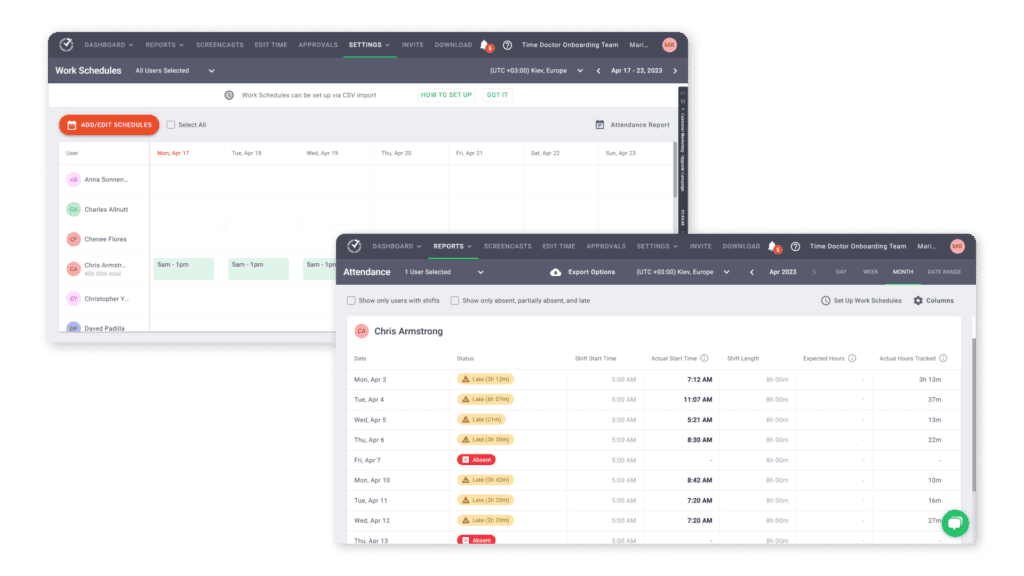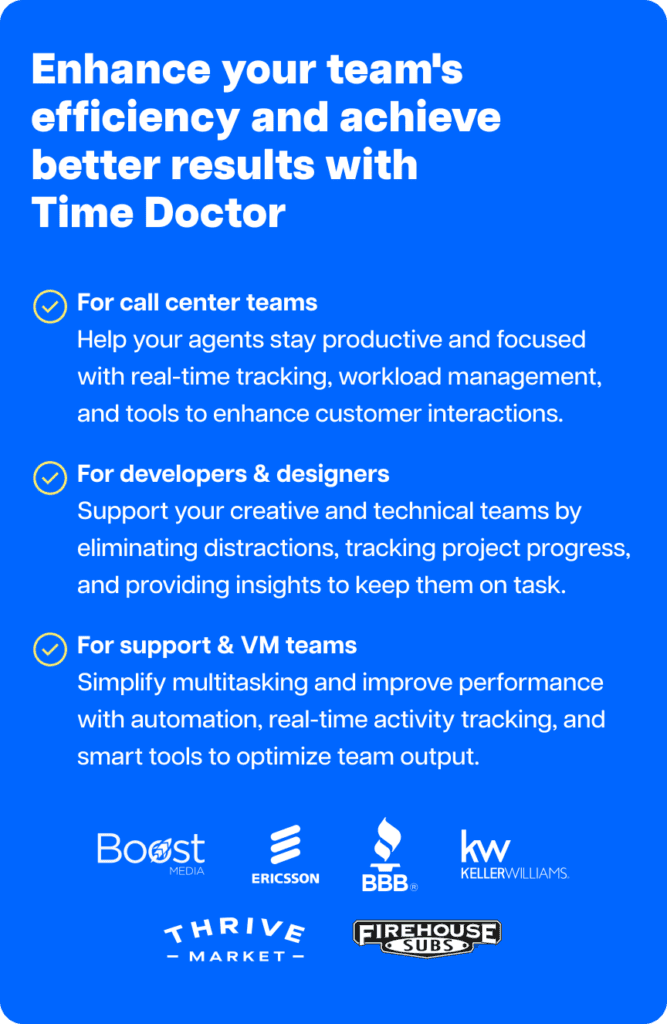Hybrid work is an ecosystem where employees can work from their home office, in a physical office, and in coworking workspaces. It’s a work model that follows a people-first approach to managing the workforce.
Hybrid work is said to increase employee productivity while addressing the challenges of remote work like isolation and lack of community. However, hybrid work can take many forms and needs to be optimized to achieve maximum productivity.
In this article, we’ll look at the 10 hybrid work model best practices that’ll work for your business. We’ll also understand why hybrid work may be ideal for your company.
Table of Contents
Let’s get going.
10 hybrid work model best practices for businesses
Here are some of the top hybrid work model best practices for businesses to follow in 2022:
1. Hire based on skills, not location
To take full advantage of a hybrid workplace, employers need to adapt and optimize their hiring practices. For example, one of the most important benefits of hybrid work is that managers can hire from a broader geographical talent pool without having to worry about the commuting distance.
In fact, a recent Accenture report indicates that over 63% of high-revenue growth companies adopted a “productivity anywhere” hybrid workforce model for their full-time employees in 2021. So one of the major best practices to follow with hybrid work is to hire based on employee talent and not the location of the workforce.
For that, managers can shift all hybrid position interviews to a virtual format. This can help assess the candidates’ readiness to adapt to a hybrid culture. Senior leaders can also open up the talent pool across locations and focus on bringing in high-quality candidates with the right attitude towards hybrid work.
2. Provide structure to employees
Every hybrid workplace will have a unique structure to promote flexible work. However, shifting to hybrid work can be intimidating, especially if your company has previously worked with an in-office work model,
In this case, it’s best to analyze your company’s needs and establish some hybrid working guidelines for your employees. Consider answering the following questions:
- As an employer, what are your expectations from your employees when they’re working hybrid?
- What data protection guidelines will each employee need to follow?
- What kind of communication etiquette does your company expect from your employees?
- What resources (internet connection, tools, etc.) are available to them?
Ideally, you can provide your new hire recruits and existing employees with an orientation about how the hybrid working model will be and the structure to follow. Address any questions and give your employees enough time to adapt.
3. Establish some ground rules
Clear, concise, and commonly accepted ground rules are important for the success of any kind of work environment. They help establish boundaries for employees to act upon when you’re switching to or implementing a hybrid model.
For example, you can ask your team members to notify their managers in advance whenever they work remotely. This helps keep track of each employee’s hybrid schedule while still effectively collaborating with teams.
Other examples of actionable ground rules include:
- Allow team members to ask for help on work commitments when needed.
- Be flexible on the virtual dress codes and appearances as long as those preferences are appropriate to the meeting objective and mood.
- Allow team members to decide their own work hours and work locations, as long as they participate in team-building activities and maintain appropriate work outputs.
- Let the team collectively determine response times for various virtual collaboration tools like Slack, Microsoft Team, Google Workspace, Zoom, etc.
- Use video calls to encourage remote employees and in-office teams to equally participate in hybrid meetings.
- Agree on remote team collaboration standards, communication etiquette, etc.
4. Invest in company-wide communication
Effective communication should be at the base of every hybrid work model. So it only makes sense to invest in tools and software that will facilitate clear communication.
For example, you can have your employees sign up on tools like Slack or Microsoft Teams and leverage ‘statuses’ to indicate when they’re offline, on a break, in a break, or working remotely.
5. Manage employee productivity
Before the COVID-19 pandemic, the lack of technological resources prevented companies from adapting to a remote or hybrid environment. However, that has changed.
As a manager, you can invest in centralized cloud-based systems for knowledge transfer and collaboration. In addition, depending on your company’s needs, you should invest in the appropriate project and document management tools, employee engagement platforms, and more.
Companies may also invest in productivity management tools like Time Doctor to prioritize productivity while avoiding employee burnout.
What is Time Doctor?

Time Doctor is a powerful employee productivity and time management tool used by large organizations like Ericsson and small businesses like Thrive Market. It offers a range of features that can optimize your company’s workflows with ease.
Here are some of Time Doctor’s handy features:
A. Automatic and manual time tracking
Time Doctor offers two time tracking modes so hybrid employees can track their work activities from wherever they’re working each day. They can use the manual mode, which has a time clock with a Start/Stop timer to log time.
Time Doctor also offers an automatic mode which has a timer that automatically starts tracking computer activity when employees turn on their PCs. This helps employees to focus on their workflows without having to worry about tracking time manually.

B. Idle time tracking
The idle time feature can help employees understand their productivity patterns and optimize their work processes. It helps employees avoid passing off non-work time as productive and stay away from unproductive tasks, especially when working hybrid.
It has an inbuilt feature that sends an idle time pop-up alert to the user if it doesn’t detect any mouse and keyboard activity for some time. If the employee fails to respond to the alert, the tool will automatically pause the timer. Managers can customize the time limit for inactivity.

Note: Time Doctor doesn’t support keylogging. The app only checks if there was any mouse or keyboard activity.
C. Projects and tasks
Time Doctor offers impressive project management features for hybrid managers and teams. Managers can assign projects and tasks to individual members. Employees can then create specific tasks under each project to track time against them.

D. Productivity ratings
Productivity ratings let managers categorize apps and websites as productive, unproductive, neutral, or unrated, depending on the nature of the employee’s work.
For example, apps like Instagram or LinkedIn are productive for social media managers while they can be unproductive for others like the accounting team.

E. Detailed productivity reports
Time Doctor can generate comprehensive productivity reports based on your employees’ time tracking habits. They include:
- Hours tracked report: The total number of hours tracked on a daily, weekly, or monthly basis.
- Timeline report: Daily or weekly reports of total time tracked.
- Web and app usage report: Websites and applications visited during work hours.
- Projects and tasks report: Time spent on each task and project over a certain time period.
- Attendance report: Detailed reports of when an employee was present, absent, late, or partially late.

6. Practice hybrid team building
Team building is critical to any hybrid company’s success. So irrespective of which hybrid work mode you adopt, actively encourage virtual collaboration and participation.
You can do this through virtual or physical office team-building exercises. For example, you can host trivia competitions, icebreaker challenges, or quizzes to help your teams feel connected to each other. Not only does it boost team productivity, but also helps reduce internal competition and conflict.
Check out these 62 virtual team-building activities for remote and hybrid teams!
7. Find ways to re-emphasize the company’s core values
If you’re looking at hybrid work as a long-term solution to your business needs, your company culture needs to be embedded into the very fabric of your shared digital space.
Managers should find ways to spot, acknowledge, and reinforce value-driven behavior in digital settings. For example, your hybrid training or orientation can highlight values like leadership, integrity, honesty, and accountability.
Senior management and leadership can then recognize and appreciate hybrid workers or remote workers that display these qualities. Managers can also reward them through bonuses, awards, or written recognition.
8. Define the KPIs for all employees
Managers will also need to define and monitor individual KPIs for hybrid employees.
These can include:
- Employee experience indicators (employee engagement, face-to-face and virtual meeting participation, collaboration, etc.).
- Profit or revenue generated.
- Customer acquisition or support tickets (for sales staff).
- Internal process quality (how productive or efficient each employee is).
- Participation in development opportunities, etc.
9. Consider employee perspective when designing workflows
A hybrid work environment allows employees to adapt to different shifts, locations, and workflows. So it’s important to consider various perspectives when designing workloads.
Managers can conduct surveys to understand individual preferences and work arrangements that benefit their hybrid teams.
However, they should also consider the risks, safety, security, and effectiveness of operations. This can allow managers to strike a balance between flexibility and efficiency and improve the chances of success with this work model.
10. Prioritize employees’ physical and mental health
According to the World Health Organization, for every $1 invested into employee wellbeing, there’s a return of $4 in improved health and productivity. So it’s safe to say that hybrid work practices that don’t prioritize employee health can not be viable for long term.
The best way to navigate these is by seeking active employee feedback and being flexible with your approach to work. Here’s how you can do that:
- Promote a healthy work life balance.
- Cut down on unnecessary hybrid meetings and prioritize internal communication.
- Have frequent conversations about employee workloads.
- Focus on providing appropriate employee benefits like paid leaves, time off, flexible shifts, etc.
In fact, a recent Mckinsey survey indicates that modern employers have to take a multifaceted approach to attract and retain talent. This includes identifying the various employee needs and providing effective solutions to cater to these gaps.
Want to know more? Learn the 5 important benefits of employee wellness programs here.
So does this mean hybrid work is better than remote or in-office work?
Let’s take a look.
Why choose a hybrid work model for your company
A hybrid work model can optimize several work processes by bringing together the best of in-office, remote, and semi-remote strategies. Team members can migrate between various locations depending on the work they need to get done.
Moreover, choosing a hybrid work form lets you have the flexibility to choose from different models like:
- Flexible work model: Productivity anywhere.
- Fixed hybrid work model: Fixed work hours divided between remote and in-office modes).
- Office-first hybrid work model: Hybrid mode with a greater emphasis on in-office work).
- Remote-first hybrid workplace model: Hybrid mode with a greater emphasis on remote work).
So depending on your company’s needs, you can personalize your work solutions according to your employees’ convenience. Not to mention, you and your employees can also enjoy other benefits, including:
- Improved work life balance.
- Maximized productivity and employee satisfaction.
- More focus on employees’ physical and mental health.
- Lower office space and infrastructure costs.
- Better, more effective use of company and employee time, etc.
That’s why if hybrid work is the right choice for your company, don’t hesitate to experiment with its various models!
Final thoughts
Hybrid work has been increasingly popular since the COVID-19 pandemic and is often considered the future of work by industry leaders. More and more companies are realizing the innumerable benefits of hybrid work and are adopting it to stay at the top of their game.
So if you’re looking to make the switch for your employees, now is the time to learn about the top hybrid work best practices. Refer to this guide for any help you may need, and be sure to follow a productivity-first approach!

Liam Martin is a serial entrepreneur, co-founder of Time Doctor, Staff.com, and the Running Remote Conference, and author of the Wall Street Journal bestseller, “Running Remote.” He advocates for remote work and helps businesses optimize their remote teams.


